Moray eel
Moray eels are a family of eel. Sometimes they are also called by their Latin name Muraenidae. Moray eels can be found all over the world. There are 200 different species in 15 genera.
| Moray eel | |
|---|---|
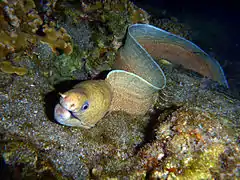 | |
| Moray eel | |
| Scientific classification | |
| Kingdom: | |
| Phylum: | |
| Class: | |
| Superorder: | Elopomorpha |
| Order: | |
| Family: | Muraenidae Rafinesque, 1810 |
| Genera | |
|
See text. | |

Body
Like other eels, Moray eels look something like a fish and something like a snake.
The body is generally patterned. In some species, the inside of the mouth is also patterned.
Moray eels normally have wide jaws and large sharp teeth, but some types of Moray eel have blunt teeth which help them to eat animals that live in shells. Morays also have pharyngeal jaws inside the main jaws.
Typically, moray eels grow to a length of about 1.5 metres. The largest known moray eel is the Slender giant moray, which can reach 4 metres in length. Moray eels live in coral reefs and rocky areas, at a depth of about 200m.
Habitat
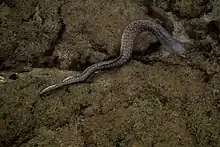
The moray eel can be found in both freshwater habitats and saltwater habitats. However most live in the sea in salt water, never entering fresh water.

Moray eels normally live in warmer waters, but it depends on the type of eel.
Feeding behavior
Morays are opportunistic, carnivorous predators[2] and feed primarily on smaller fish, crabs, and octopuses.[3]
There are not many animals that eat eels, but groupers, barracudas and sea snakes do eat them.[4] Humans also eat eels.
Relationship with humans
Humans eat eels, but sometimes Moray eels will give people food poisoning. Moray eels are also caught to put in aquariums for people to look at. Some types of Moray eel may be considered beautiful and hard to find, in which case they will be expensive to buy.
Gallery
 Anarchias seychellensis
Anarchias seychellensis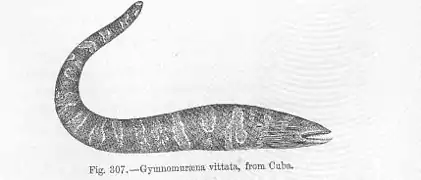 Channomuraena vittata
Channomuraena vittata Echidna nebulosa
Echidna nebulosa Enchelycore schismatorhynchus
Enchelycore schismatorhynchus.jpeg.webp) Enchelynassa canina
Enchelynassa canina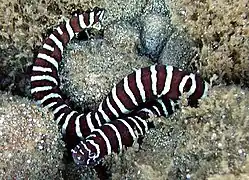 Gymnomuraena zebra
Gymnomuraena zebra Gymnothorax favagineus
Gymnothorax favagineus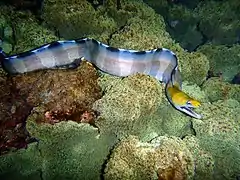 Gymnothorax rueppelliae
Gymnothorax rueppelliae Monopenchelys acuta
Monopenchelys acuta Muraena helena
Muraena helena.JPG.webp) Pseudechidna brummeri
Pseudechidna brummeri_(6052858389).jpg.webp) Rhinomuraena quaesita
Rhinomuraena quaesita Scuticaria tigrina
Scuticaria tigrina Strophidon sathete
Strophidon sathete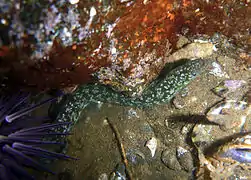 Uropterygius xanthopterus
Uropterygius xanthopterus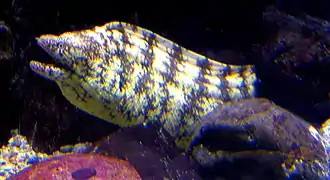 Gymnothorax kidako
Gymnothorax kidako
Further readings
- Gross, Miriam J.. The Moray Eel. United States: Rosen Publishing Group's PowerKids Press, 2005.
- Purser, Phillip. Keeping Moray Eels in Aquariums. United States: T.F.H., 2005.
- Didier, Dominique A.. Moray Eel. United States: Cherry Lake Publishing, 2014.
- Goldish, Meish. Moray Eel: Dangerous Teeth. United Kingdom: Bearport Publishing, 2009.
References
- Froese, Rainer, and Daniel Pauly, eds. (2009). "Muraenidae" in FishBase. January 2009 version.
- Kooser, Amanda. "See a snowflake moray eel swallow a sushi snack in an extraordinary way". CNET. Retrieved 2021-06-17.
- Young, Robert F.; Winn, Howard E. (February 2003). "Activity Patterns, Diet, and Shelter Site Use for Two Species of Moray Eels, Gymnothorax moringa and Gymnothorax vicinus, in Belize". Copeia. 2003 (1): 44–55. doi:10.1643/0045-8511(2003)003[0044:APDASS]2.0.CO;2. ISSN 0045-8511. S2CID 85897128.
- "Moray Eel - Facts and Beyond". Biology Dictionary. 2020-07-10. Retrieved 2021-06-17.
Other websites
- Moray Eels Grab Prey With Alien Jaws
- Smith, J.L.B. 1962. The moray eels of the Western Indian Ocean and the Red Sea. Ichthyological Bulletin; No. 23. Department of Ichthyology, Rhodes University, Grahamstown, South Africa.